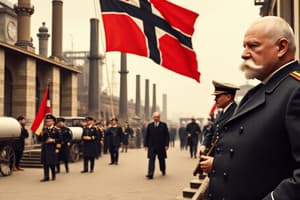Podcast
Questions and Answers
Care dintre următoarele industrii au fost esențiale pentru dezvoltarea economică a Imperiului German în perioada 1870-1914?
Care dintre următoarele industrii au fost esențiale pentru dezvoltarea economică a Imperiului German în perioada 1870-1914?
- Oțel (correct)
- Agricultură
- Textile
- Produse alimentare
Ce aspect a caracterizat expansiunea militară a Germaniei sub conducerea lui Otto von Bismarck?
Ce aspect a caracterizat expansiunea militară a Germaniei sub conducerea lui Otto von Bismarck?
- Promovarea pacifismului în societate
- Abandonarea tehnologiilor navale
- Reducerea bugetului militar
- Crearea unei armate permanente puternice (correct)
Cum era structurată politică a Imperiului German?
Cum era structurată politică a Imperiului German?
- Federatie cu putere egal distribuită între state
- Republică democratică cu alegeri directe
- Monarhie constituțională cu puteri limitate pentru Reichstag (correct)
- Monarhie absolută cu control total al Kaiserului
Care dintre următoarele aspecte reflectă cel mai bine impactul militarismului în societatea germană?
Care dintre următoarele aspecte reflectă cel mai bine impactul militarismului în societatea germană?
Ce fel de politică economică a fost adoptată pentru a proteja industriile interne ale Germaniei?
Ce fel de politică economică a fost adoptată pentru a proteja industriile interne ale Germaniei?
Flashcards
Industrializare rapidă a Germaniei
Industrializare rapidă a Germaniei
Dezvoltarea rapidă a industriei în Imperiul German între anii 1870 și 1914, stimulată de inovații tehnologice, capital de investiții și acces la materii prime.
Expansiunea militară germană
Expansiunea militară germană
Modernizarea și extinderea forțelor militare germane sub conducerea lui Otto von Bismarck, cu o investiție semnificativă în tehnologie și o forță militară permanentă.
Structură politică a Imperiului German
Structură politică a Imperiului German
O monarhie constituțională, unde Kaiserul (împăratul) avea putere considerabilă, iar Reichstag-ul (camera inferioară a parlamentului), o influență limitată.
Industrii cheie ale Germaniei
Industrii cheie ale Germaniei
Signup and view all the flashcards
Rivalitatea navală pre-Primul Război Mondial
Rivalitatea navală pre-Primul Război Mondial
Signup and view all the flashcards
Study Notes
Economic Development
- The German Empire experienced substantial industrial growth from the 1870s to 1914. This rapid industrialization was driven by technological innovation, investment capital, and access to raw materials.
- Key industries included coal, steel, chemicals (like dyes and pharmaceuticals), and manufacturing of machinery.
- The development of a vast railway network facilitated the transport of goods and resources across the empire, supporting economic growth.
- Germany rapidly became a major industrial power, rivaling Great Britain.
- Significant investments in infrastructure accelerated economic expansion.
- Technological advancements significantly improved productivity and efficiency.
- However, this economic growth was not evenly distributed across all social classes. While some prospered, significant poverty existed alongside wealth.
- The rise of large industrial conglomerates (trusts or cartels) characterized the business landscape.
- Government policies and protectionist tariffs shielded domestic industries from foreign competition.
Military Expansion
- Under the leadership of Otto von Bismarck, the German military was extensively modernized and expanded. The creation of a powerful standing army was paramount.
- Significant investment was made in military technology, including naval development, reflecting a focus on sea power as well.
- The expansion of the military was a demonstration of German ambitions on the European stage.
- The development of the German navy, particularly under Kaiser Wilhelm II, challenged British naval dominance. The naval race became a significant aspect of pre-World War I tension.
- Military service was mandatory for most men, further strengthening the military's impact on society.
- Militarism was deeply embedded within German society, becoming a defining aspect of national identity during this period.
Political Structure
- The German Empire was a constitutional monarchy in which the Kaiser (Emperor) held considerable power.
- The Reichstag, the elected lower house of parliament, had limited influence on the Kaiser and government.
- The Chancellor, the head of government, was responsible to the Kaiser, not the Reichstag.
- The upper house of the parliament (Bundesrat) represented the states of the empire, and had significant power as well.
- Political parties varied and included conservative, liberal, and socialist factions. Conflict existed between these groups.
- The Prussian influence in the political structure was substantial, shaping policies and political culture.
- While the empire was a nation-state, ethnic and cultural tensions existed between different groups within its population.
- The political system's structure and power dynamics made compromise and effective governance challenging at times.
- The growth of political activism, including socialist movements, challenged the existing power structures.
Studying That Suits You
Use AI to generate personalized quizzes and flashcards to suit your learning preferences.




